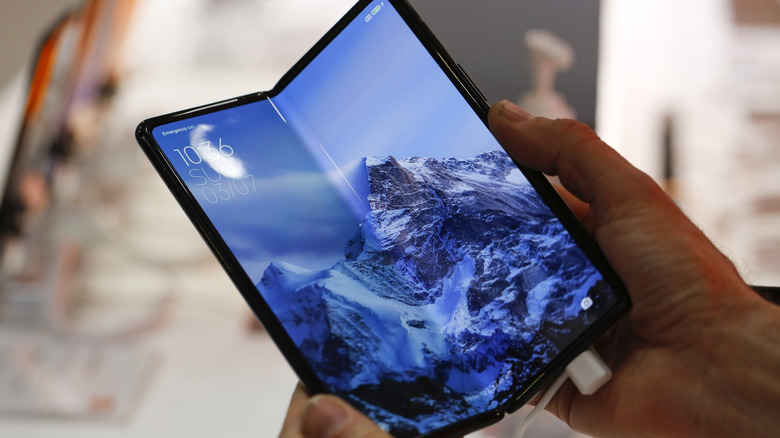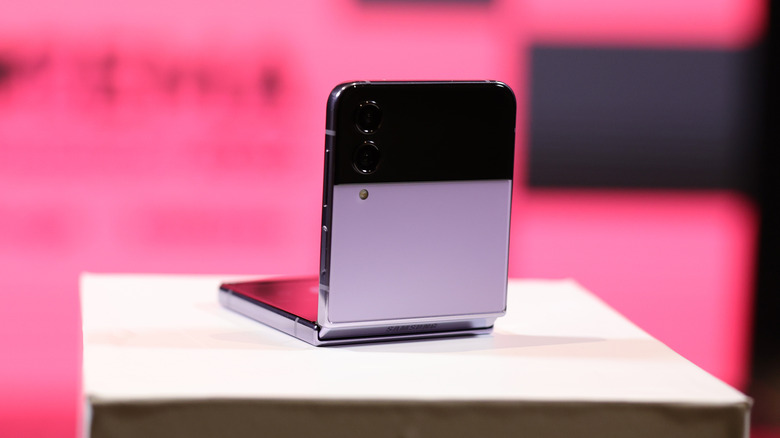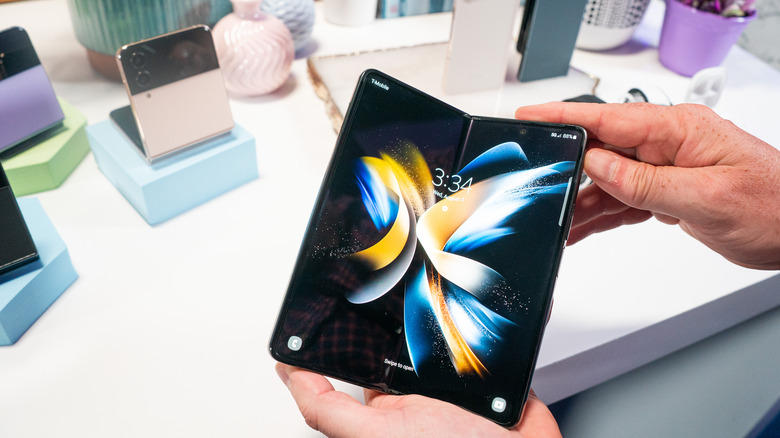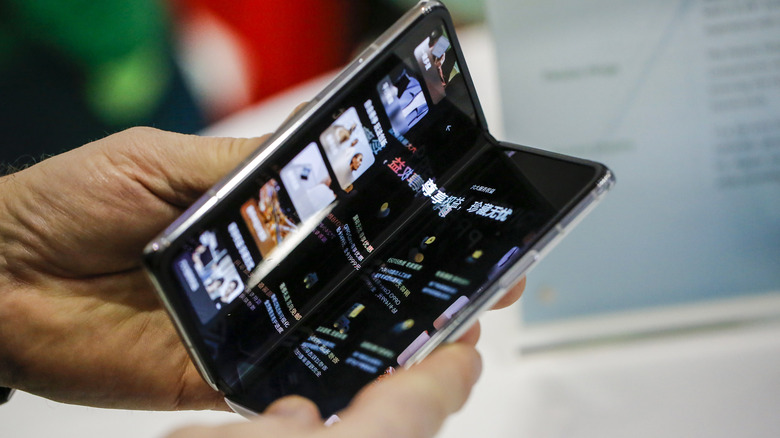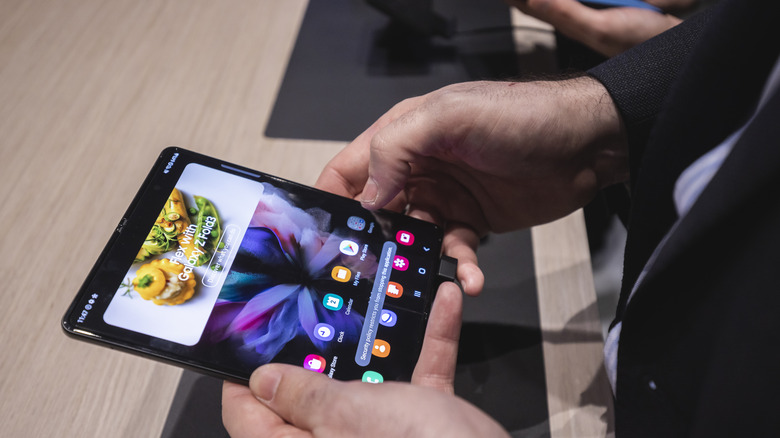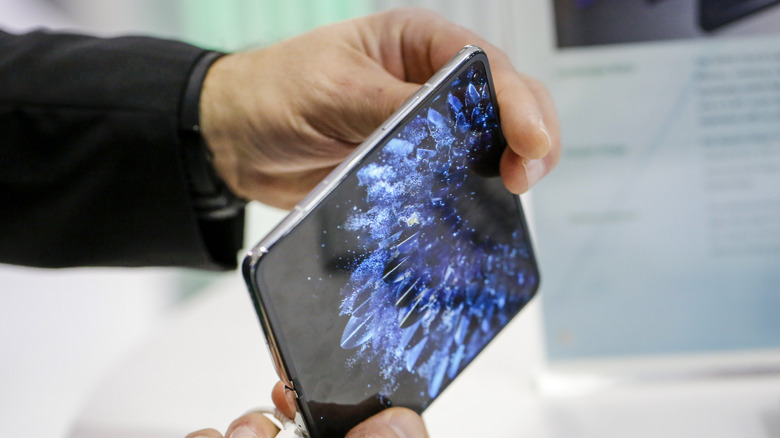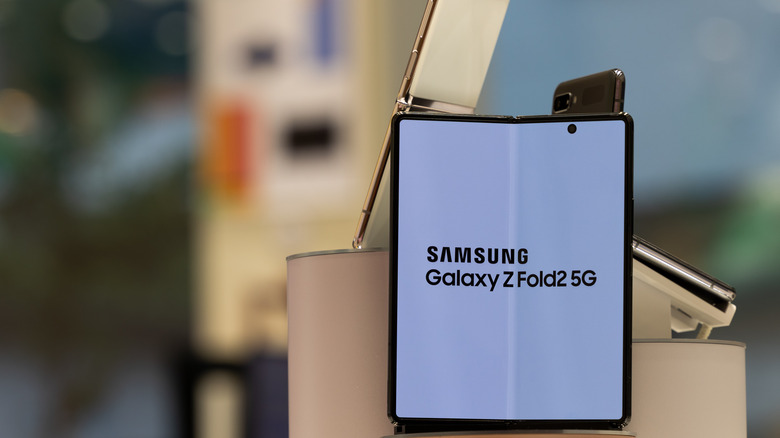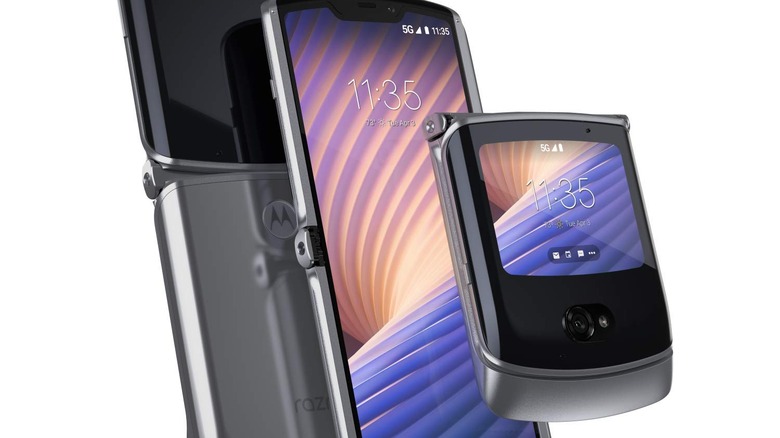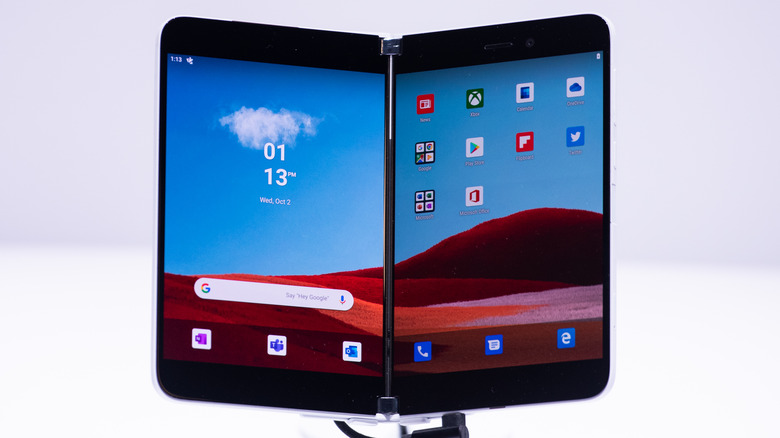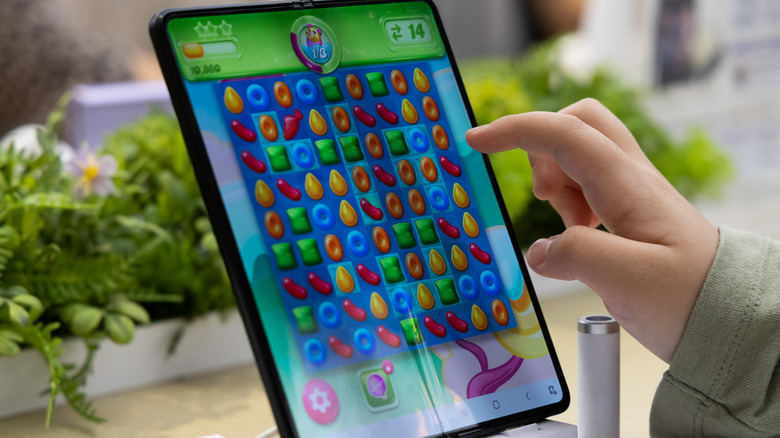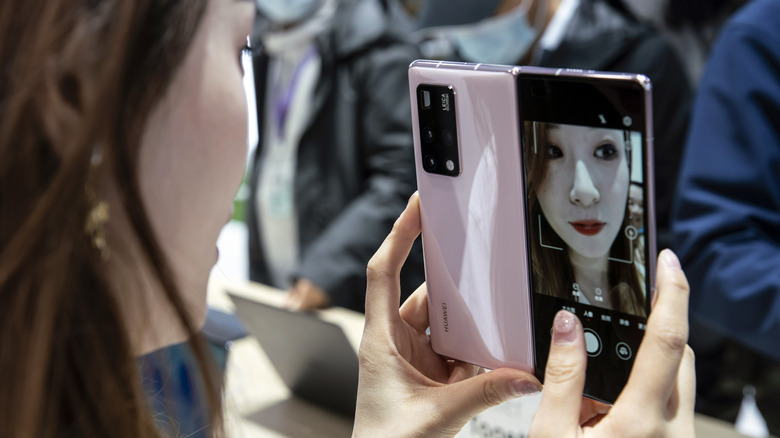Myths You Should Never Believe About Foldable Phones
We may receive a commission on purchases made from links.
Before Samsung released its first foldable in 2019, the smartphone space had already been inundated with articles and opinions about foldable phone technology. As far back as 2013, the company hinted at a possible release of devices with folding displays. Some smartphone users and enthusiasts met this news with admiration, while earnestly waiting for Samsung to deliver on this proposal. Others were indifferent, as they doubted either the engineering feasibility of the foldable phone or its ability to become a game changer. Today, with the fourth iterations of both the Samsung Galaxy Z Fold and Samsung Galaxy Z Flip in the market, these opposing sides have come to terms with the foldable phone as a thriving niche of smartphone technology.
But that does not mean everyone is willing to purchase these phones. If nothing else, some commonly held myths make people unwilling to do so. From the idea that foldables are too fragile for their cost, to the belief that the foldable design will eventually die off, such myths hinder many from spending cash to own a device. Also, while other tech gadgets and components — such as the camera — suffer from public misinformation of many sorts, many of the myths about foldable phones point to what they cannot do or how they underperform.
Given the attention that foldable phones have garnered, it is both timely and appropriate to dispel these myths and, in doing so, encourage a larger population of smartphone users to embrace this innovation.
Foldable Phones Are Too Bulky
There's no better place to start than from the idea that foldables are too heavy to use — and hence not portable. The majority of smartphones today fall within the range of 150 to 250 grams in weight, with flagship phones weighing heavier than midrange and low-budget devices due to exterior material composition. As such, many smartphone users may have calibrated their expectations of smartphone weight to fall into this category; anything lighter than 150g would lack every sense of premium feel, and anything heavier than 250g would be too heavy for a handheld device.
With foldable phones being heavier than this perceived upper limit, then, it's easy to see how their weights could be an issue. But anyone who holds a foldable would immediately realize that this is a myth. Foldable phone manufacturers have worked to make their phones lighter in subsequent editions: the 262-gram Xiaomi Mi Mix Fold 2, for instance, weighs a whopping 70 grams less than the first Xiaomi Mi Mix Fold, and the Samsung Galaxy Z Fold 4 is also lighter than the first Galaxy Fold.
It would be more surprising if foldable phones weighed within the same range as smartphones, as they are obviously larger in total surface area and thus require extra material to build. This is why the Oppo Find N2 has drawn public attention for being lighter than the iPhone 14 Pro Max. In any case, the weight of these foldable devices hasn't been any more of an issue than it's been with any other major smartphone on the market today.
The Screen Will Break Sooner Than Later
If a critic does not think that foldable phones are too bulky, there's a chance that they have an issue with the screen. This misconception about foldable phone screens has thrived, due to how these screens work and the early review display damage disaster which occurred with the Samsung Galaxy Fold in 2019. With respect to the former, the first foldable phones featured screens made with polymer-based materials, as it was infeasible then to make flexible glass for commercial tech products.
This was until Samsung released its Ultra-Thin Glass (UTG) technology, featuring a glass material manufactured to maintain its durability even when folded. With respect to the latter, reviewers ran into screen problems with the first Galaxy Fold. In trying to remove what seemed like a screen protector, those who had been issued review units found that their screens were no longer functioning — with dead pixels on some screens and a total blackout on others.
But this was three years ago, and so much has changed since then. More foldable phone manufacturers, including Xiaomi, now use Samsung's UTG technology for their folding screens. Plus, Samsung has since figured out how to pair UTG with top-tier screen materials like Corning Gorilla Glass Victus+, as is used on the Samsung Galaxy Z Fold 4, while still maintaining the high quality and resolution of the Dynamic AMOLED display. All of this means that the screens on the latest foldables are just as good or even better than those on today's highest-end conventional smartphones.
The Battery Life is Poor
All smartphones and foldable phones come with batteries capped at a specific milli-Amp hour (mAh) rating. In addition, how long a battery lasts depends largely on how the device is used and what apps are being run. These imply that foldable phones would be expected to consume battery power faster than conventional smartphones, due mostly to larger screen size and increased pixel activity.
However, this does not mean that battery life is poor in your average foldable smartphone. The battery capacities on today's foldable phones are similar to those on normal smartphones: two examples are the Xiaomi Mi Mix Fold 2 and Samsung Galaxy Z Fold 4, with battery capacities of 4500 mAh and 4400 mAh respectively. It's also important to note that foldable phone manufacturers cannot increase the size and thus the capacity of phone batteries without restrictions, as this would lead to an increase in weight — which, as we have seen, is already an issue for smartphone users.
Nonetheless, the great news is that foldable phones are getting even better at battery power management. This is thanks both to a streamlining of foldable phone design and components and to improvements in smartphone chipset technology. The Samsung Galaxy Z Fold 4 demonstrates how its Snapdragon 8+ Gen 1 chip ensures that tasks are run on the phone with minimized power demands. Plus, users have the option to reduce the refresh rate and thus conserve battery life. Battery life isn't better than it is on comparable non-foldable phones, but it isn't shockingly worse.
Foldables Don't Have Water Resistance
Just like the first smartphones, the earliest foldable phones did not feature water resistance. This was perhaps not a priority at the incipient stages of foldable phone technology, as the focus was on testing the market acceptance of the product. In 2021, the Samsung Galaxy Z Fold 3 and Galaxy Z Flip 3 debuted as the first foldable phones with water resistance. They were both rated IPX8, meaning that they could be operated in certain wet conditions including rain. The Samsung Galaxy Z Fold 4 and Galaxy Z Flip 4 also share the same IPX8 rating, and it is expected that Samsung would keep improving on the water-resistance technology for its foldable phones going forward.
For these Samsung foldables, then, it's worth noting what the IPX8 rating does and does not cover. Besides being unaffected by rainfall and accidental liquid spills, these devices can also be cleaned with water. This cleaning could be done by sprinkling water on the phone's surface and wiping it with a cloth, or by immersing the phone in clean water, followed by towel drying.
With particular respect to phone immersion, Samsung has specified the IPX8 conditions as 30 minutes maximum, in up to 1.5 m deep water, at the temperature and pressure ranges of 59-95°F (15-35°C) and 86 – 106 kPa respectively. Samsung foldable phone users are also reminded that being water-resistant does not imply being water-proof and that regardless of water resistance rating, foldable phones remain electronic devices that can be damaged by water.
The Camera Quality Doesn't Translate Well to the Big Screen
Most foldable phones today feature two sets of cameras: one atop the big screen (a typical front camera), and the usual rear camera setup. As is the case with conventional smartphones, the rear cameras have better specifications and thus take better pictures than the front cameras. The Xiaomi Mi Mix Fold 2, as an example, houses a triple camera setup on its rear: a 50 MP main wide camera, an 8 MP telephoto lens with optical zoom, and a 13 MP ultrawide camera with a 123-degree field of view.
It is evident that with such high-level camera specifications, the best place to view pictures and videos would be on a large, high-resolution screen. This is exactly what foldable phones provide. The Xiaomi Mi Mix Fold 2, with a screen resolution of 1914 by 2160 pixels, easily provides a better camera experience than smaller smartphones. The same is true of the Samsung Galaxy Z Fold 4, which features a 50 MP main camera, a 12 MP ultrawide sensor with a 123-degree field of view, a 10MP 3x optical zoom telephoto lens, and 1860 by 2480 pixel resolution on the big screen to match.
It would seem that foldables are yet to get it right with front cameras. Despite increasing the front camera's pixel count, the images and videos still do not come out as high in quality as those from the rear camera setup. But as with many other parts of the foldable phone's build, this area will see major improvements going forward.
The Crease Diminishes the Viewing Experience
While foldable phones have continued to improve in design and quality year-on-year, the crease in the middle of the big screen remains a major engineering challenge. It was more noticeable in earlier foldable phones, where users could not only feel the groove running down the screen's center while using the phone but also see its effects on the screen.
As such, it seemed that with every instance of opening and folding the phone, the crease would worsen and the groove would get deeper. Fortunately, foldable phone manufacturers have developed major screen improvements to reduce or completely eliminate this crease. A quick comparison of the Samsung Galaxy Z Fold 4 and Galaxy Z Flip 4 against the first Galaxy Fold and Galaxy Flip editions would reveal just how far the company has come: the crease is less felt on the screen, and it is less noticeable at normal viewing angles.
In addition, there's a lot of ongoing work on display technology that would completely eliminate the crease. Samsung is expected to inch even closer to a crease-free screen with its highly anticipated Galaxy Z Fold 5 and Galaxy Z Flip 5 devices. Plus, LG is developing a totally new screen material. Tagged the "Real Folding Window," it is touted to cause no crease when folded, while maintaining strength, durability, and drop resistance. It would be exciting to see if this takes off like Samsung's UTG technology.
Foldable Phones Cannot Replace Conventional Smartphones
The debate as to whether foldable phones can replace smartphones as a daily driver has already become mainstream in the tech space. For proponents, the answer is a clear yes: foldable phones are designed to be smartphone-tablet hybrids, and thus offer increased functionality in a similar form factor. To them, nothing beats enjoying the benefits of a tablet with just a few millimeters of increased thickness compared to a smartphone. Plus, it could be more cost effective to purchase a foldable phone than to buy a flagship smartphone and top-tier tablet together.
For opponents, the answer is a clear no. In terms of cost, foldable phones remain expensive by themselves — and thus the average consumer would much rather get a conventional smartphone than purchase a foldable. In terms of use, smartphones are still easier to operate than foldables while meeting basic phone needs, and only those interested in the most premium smartphone tech capabilities would be interested in owning one of these new devices.
Plus, there's almost nothing that makes the foldable phone indispensable as a tech product. In terms of technology, foldable phones are simply not yet compelling enough to swing a major portion of the consumer base to their side.
Foldables cannot replace tablets
Just as they contest with smartphones, foldables are also in competition with tablets. Several tech creators have run comparisons of the Samsung Galaxy Z Fold phones with the iPad Mini tablets, and it would seem that the Fold products outperform the iPad Minis overall. Besides the differences in display, camera quality, and performance, there are several software features and functions that make the foldable phone more attractive than tablets.
The latest on the Samsung Galaxy Z Fold line also features an S-Pen stylus, which enables the foldable phone to be used for taking notes like a normal tablet. Plus, we can't ignore the fact that Galaxy Z Fold phones can be folded.
But foldable phones still make a statement for themselves when compared with high-end tablets. The Samsung Galaxy Z Fold 4 and Xiaomi Mi Mix Fold 2 both maintain a competitive level of performance while featuring a crystal-clear display, housing excellent rear cameras, working with a stylus, and managing battery life adequately. For consumers who prefer a larger screen, the iPad Pro clearly wins as a tablet competitor. But the screen size is hardly a fair metric for comparison, as foldable phones have to be built within size limits that keep their identity as a phone and tablet at once.
Mobile Apps and Games Don't Run Well on Foldables
As foldable phones become more popular and accepted, they are having an increased impact on the development of mobile apps and games. Software engineers and designers have to create apps responsive enough to work on both screens, and in some cases, the apps should be capable of switching seamlessly from the smaller screen to the larger screen as the user sees fit.
Besides ensuring a seamless transition between foldable phone screens, developers also face the challenge of building for several foldable form factors. This is similarly complicated, as the screen sizes of foldable phones vary in both length and width. Along these lines, apps and games also have to be designed for different screen orientations. Worthy of note here is the Samsung Galaxy Fold lineup, which can be used like laptop computers by folding the phone to an obtuse angle. Apps and games must be built so that even when the foldable phone is set as such, both screens are properly occupied with useful content. This is not to mention the anticipated variations in foldable phone technology, such as the concept of a three-screen fold as against today's two-screen fold.
All of these have of course created a new angle in the mobile app and game development industry, and developers are stepping up to the challenge. That foldable phones have continued to sell is an obvious indication of this. In addition, this will contribute to advancements in software and programming, making it easier to build great digital products for foldable phones.
Foldables Are A Fad That Won't Last
The foldable phone has attracted so much attention and competition within the few years of its market presence. Its growth might not seem like a lot, considering that it does not rack up nearly the amount of unit sales annually as top-end flagship phones. But when one considers that the global foldable phone market is projected to reach 26 million units by 2023 (via Counterpoint), then things begin to make more sense. As a niche category of smartphone devices, foldables grew the fastest in 2022, with Samsung leading the pack. Moreover, the company earlier announced that consumers were switching to Samsung in order to get their hands on the Galaxy Fold and Flip phones.
While it's clear that Samsung is committed to this foldable phone journey, the decisions are mixed among other smartphone manufacturers. Xiaomi, Huawei, Motorola, and Oppo already have their foldable phones in the market, some with multiple variants. The Xiaomi Mi Mix Fold 2, which was built to directly challenge Samsung's Galaxy Z Fold 4 (and was in fact released the day after the Fold 4), points to Xiaomi's desire to aggressively emerge as a market leader in foldable phones. Other brands like Google and Apple, despite much anticipation and prodding from fans, have not yet released any foldable phones.
Compared to other smartphone concepts that have arisen and quickly disappeared over the years, foldable phones have survived for a remarkably long time. If Samsung has anything to say about it, foldables won't be going away any time soon.
